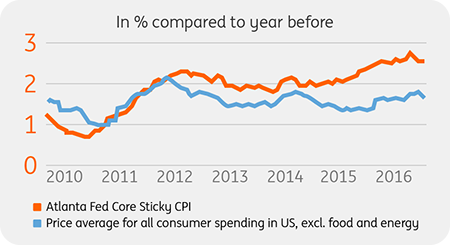Rising ticket prices? Interest rate up!
6 February 2017
In the first in a new quarterly series about unknown predictive economic indicators, macroeconomist Maarten Leen puts the spotlight on the Atlanta Fed Core Sticky CPI.

Admission prices for amusement parks are usually adjusted only once a year. For one simple reason: it is too expensive to change brochures, websites and check-out systems more often.

Maarten Leen is head of Macroeconomics
at ING Global Markets Research.
US President, Donald Trump, has ambitious plans for the US economy. He wants to pump billions into building bridges and other infrastructure, while shutting the door on foreign competition so that the lights can be switched back on in US production plants. That way, the US middle class can finally start earning money again.
Sounds great. Unfortunately, the labour market is already fairly tight. For each vacancy, there are only two or three candidates available, just as before the financial crisis. That, as every economist knows, means inflation is just around the corner. The Federal Reserve (Fed) keeps a wary eye on any signs of inflation and may decide to hike rates to alleviate the pressure. But is the threat of inflation really that big? One trusty indicator for insiders is the Atlanta Fed Core Sticky CPI.
Exotic delicacy
But why the Atlanta Fed Core Sticky CPI? Pronounce it quickly, and it sounds like some kind of exotic delicacy. Actually, it is something entirely different.
“CPI” is the abbreviation for Consumer Price Index. So it has something to do with inflation. “Sticky” means that the indicator only looks at goods and services whose prices are not frequently adjusted. “Core” entails that the traditionally highly flexible prices of food and energy are left entirely out of account. And “Atlanta Fed” stands for one of the 12 regional Federal Reserve Banks that make up the US central bank: the Fed.
So what’s in that sticky-price basket of goods and services? Think of home interior supplies, theme park tickets, personal care products, rents and public transport. On average, prices for these are only adjusted once every 10 months. Either because these prices can only be reset once a year by law or because changing prices lead to extra costs, for instance for reprinting brochures. Prices of other products, such as petrol, tomatoes, hotels and shoes, are far more flexible. These can change daily.
The idea is that sticky prices are only changed after a great deal of thought about where costs are headed. And when these prices are adjusted, the US central bank sees this as a valuable source of information about changing inflation expectations. Expectations that can easily translate into rising wage demands and, ultimately, higher general inflation.
According to the Atlanta Fed Core Sticky CPI, inflation at the end 2016 was 2.6 percent (see graph), well above the Fed’s target of two percent. ING assumes that the Fed will hike rates in March, with probably more increases in the pipeline this year.

